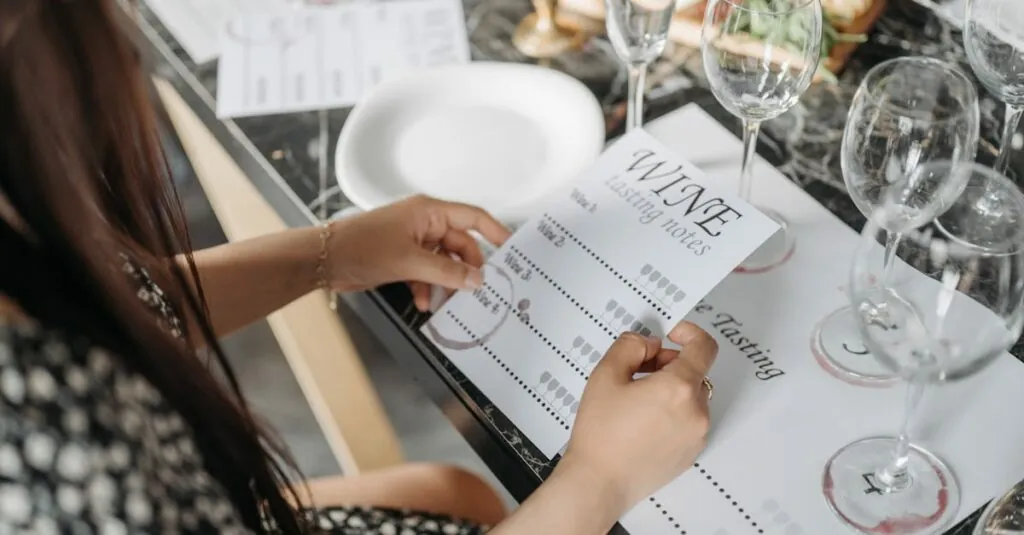Table of Contents
ToggleImagine biting into a perfectly grilled steak and realizing the only thing missing is the right drink to elevate the experience. Beverage pairing isn’t just a fancy term for wine snobs; it’s the secret sauce that can turn an ordinary meal into a culinary masterpiece. Whether it’s a zesty cocktail, a bold red, or a refreshing craft beer, the right beverage can complement flavors and make taste buds dance like nobody’s watching.
Understanding Beverage Pairing Notes
Beverage pairing notes provide essential guidance for selecting the optimal drink that complements a meal. These notes highlight flavor profiles, aromas, and textures, ensuring harmony between food and drink. Different beverages, like wines, beers, and cocktails, offer unique attributes that can enhance or contrast with specific dishes.
When pairing wine, consider the acidity and sweetness. For example, a crisp Sauvignon Blanc pairs well with light salads and seafood, while a rich Cabernet Sauvignon complements robust meats, such as steak. The tannins in red wines help balance fatty cuts, creating a pleasant dining experience.
Craft beers add another dimension to pairing. A hoppy IPA excels with spicy dishes, cutting through heat and enhancing flavor. Dark beers, like stouts or porters, provide depth that matches rich desserts and grilled meats, creating a perfect match.
Cocktails bring creativity into beverage pairing. Sweet and sour components in cocktails can elevate appetizers. For instance, a Margarita pairs wonderfully with zesty Mexican cuisine, while a classic Martini enhances the elegance of seafood dishes.
Each beverage type presents various notes, allowing for diverse pairings. Understanding these nuances helps individuals explore new flavors and preferences. Assessing body and texture is also crucial; a light drink often pairs well with delicate items, while a full-bodied beverage encourages pairing with richer foods.
Ultimately, beverage pairing notes guide diners in making informed decisions. Following these guidelines fosters a deeper appreciation for flavor interactions, elevating the overall dining experience.
The Science Behind Pairing
Understanding beverage pairing involves recognizing how flavors and aromas interact with each other. The right combination enriches the dining experience.
Flavor Profiles
Flavor profiles play a vital role in successful beverage pairing. Each drink has distinct characteristics that can either complement or contrast with food. For example, light-bodied wines often provide bright acidity, enhancing fresh fish dishes. In contrast, bold red wines may feature deep tannins, which suit rich meats. Craft beers also vary; hoppy IPAs can balance spiciness in dishes, while stouts’ roasted notes work well with decadent desserts. Identifying complementary flavors helps diners maximize their enjoyment and satisfaction with each meal.
Aroma Considerations
Aroma significantly influences perception of taste. The scent of a beverage can enhance or disrupt the overall experience. Fruity aromas in wines can evoke feelings of freshness, appealing in summer wines served with salads. Spicy notes in a whiskey might elevate smoky meats during a hearty meal. When selecting a beverage, paying attention to aroma ensures harmonious pairing. Ultimately, thoughtful consideration of aromas enriches each bite and sip, creating a more memorable dining occasion.
Types of Beverages
Beverage types significantly impact dining experiences. Understanding different beverages enhances flavor pairing.
Wine Pairings
A variety of wine options exist for pairing with food. Crisp white wines such as Sauvignon Blanc complement light salads and seafood dishes effectively. Meanwhile, richer red wines like Cabernet Sauvignon enhance the flavors of robust meats. For vegetarian options, a light Pinot Grigio pairs well with roasted vegetables, while a fruity Riesling matches spicy Asian dishes. Each wine type brings unique characteristics to meals, emphasizing the importance of selecting the right one.
Beer Pairings
Beer offers diverse choices that accommodate numerous food styles. IPAs, known for their hoppy flavors, excel with spicy and barbecue dishes. Meanwhile, lagers tend to complement lighter fare, such as grilled chicken or fish tacos. Dark beers like stouts often pair beautifully with desserts, particularly chocolate. Those who prefer wheat beers might find them an excellent match for citrus-infused foods, bridging refreshing flavors with zest. Each beer variety helps enhance dishes through complementary interactions.
Spirits Pairings
Spirits also play a vital role in beverage pairing. Vodka-based cocktails suit fresh seafood due to their clean profiles. Whiskeys, particularly those with smoky notes, work well with grilled meats, adding depth to the meal. When it comes to tequila, margaritas create a refreshing contrast with zesty Mexican dishes. Rum’s sweetness pairs nicely with tropical desserts or spicy flavors found in certain cuisines. Selecting the right spirit harmonizes perfectly with various dishes, enriching the overall experience.
Common Pairing Mistakes
Overlooking the beverage’s acidity often leads to poor pairings. Wines with higher acidity can enhance rich dishes, while low-acid beverages might overwhelm lighter flavors. Ignoring flavor profiles also results in mismatched experiences. A robust Cabernet Sauvignon can clash with delicate fish dishes, distorting the intended flavors.
Using sweet beverages indiscriminately is another common error. Sweet wines and cocktails may overpower savory foods, detracting from the meal’s complexity. Pairing bold beers with light foods often proves problematic. An IPA’s intense hop bitterness can overshadow nuanced flavors in simpler dishes, creating an unbalanced taste.
Serving drinks at incorrect temperatures affects enjoyment significantly. White wines and light beers should be chilled, while reds often benefit from slight warming. An unchilled white might taste flat, while an overly warm red can feel heavy and unapproachable.
Failing to consider regional pairings leads to missed opportunities. Many dishes have classic beverages that enhance their characteristics. For instance, a hearty Italian pasta works beautifully with Chianti, reflecting regional traditions that elevate the dining experience.
Neglecting personal preferences is also crucial. While guidelines exist, individual taste varies widely. Some diners enjoy contrasting flavors, while others favor harmonious pairings. Understanding these preferences helps create a more enjoyable experience.
Ignoring textural considerations is a mistake as well. The richness of a dish can guide beverage choice; creamy dishes often pair best with smooth wines or balanced beers. Likewise, spicy foods generally align well with refreshing, crisp drinks that cleanse the palate.
Ensuring awareness of pairing mistakes enhances the overall dining experience. Recognizing these factors allows for informed decisions and more satisfying meal enhancements.
Tips for Successful Pairing
Prioritize balance when selecting beverages. Matching the intensity of flavors in both food and drinks enhances the overall experience. For instance, a bold red wine complements a hearty steak, while a light white can boost the freshness of seafood.
Consider acidity when pairing. High-acid wines, like Sauvignon Blanc, cut through rich dishes, making them taste lighter. This characteristic works well with creamy sources and fried foods.
Aromas greatly influence taste perception. Fruity fragrances in wine heighten the sense of freshness, thereby enhancing lighter dishes. Spicy notes in cocktails can lift smoky or spicy meals, creating a harmonious pairing.
Textural elements shouldn’t be overlooked. Creamy drinks match well with similarly textured foods, ensuring a smoother experience. Conversely, crisp beverages, such as bubbly wines, provide a refreshing counterpoint to heavier dishes.
Local pairings often create memorable combinations. Foods from specific regions often share drink traditions, enhancing authenticity. Pairing an Italian dish with a local Chianti showcases this relationship effectively.
Experimentation enriches the journey. Mixing different beverages and foods can lead to delightful surprises, encouraging personal discovery. Bold choices, like pairing India Pale Ales with spicy curry, often yield exciting results.
Keeping personal preferences in mind enhances enjoyment as well. Individual tastes vary significantly, guiding optimal pairings. These nuances play a crucial role in forming lasting impressions and fostering appreciation for diverse flavor interactions.
Beverage pairing is an art that significantly enhances the dining experience. Understanding the interplay of flavors aromas and textures allows for informed choices that elevate meals. Whether it’s a crisp wine with seafood or a rich stout with chocolate dessert the right drink can transform an ordinary meal into a memorable occasion.
By considering factors like acidity intensity and personal preferences diners can navigate the complexities of pairing with confidence. Embracing local options and experimenting with different combinations opens the door to delightful discoveries. Ultimately beverage pairing is about enhancing enjoyment and fostering a deeper appreciation for the culinary experience.







